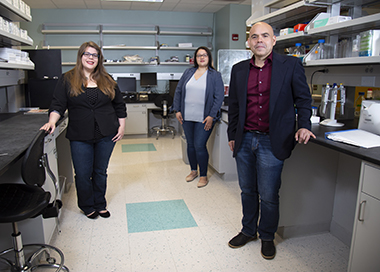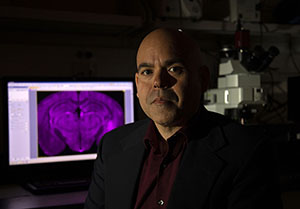Avenues of Fear
 |
|
Andrew Poulos stands in the LSRB's Poulos Research Laboratory with Ph.D. students Natalie Odynocki (left) and Lorianna Colon. Both are part of his research team participating in a $1.89 million NIMH study into fear. (Photos by Patrick Dodson) |
ALBANY, N.Y. (May 30, 2019) — Whence comes fear? Though we dread its arrival, this basic emotion promotes defensive behaviors that are essential for survival for both young and old.
Forty years of research examining how we learn about fearful experiences and the brain regions that serve this form of learning have primarily left sex and age out of the equation. Now, however, new research by Assistant Professor Andrew Poulos of Psychology, supported by a $1.89 million award from the National Institute of Mental Health, delves into this aspect of fear-learning where nearly all other studies have not.
“Prior research has largely focused on the adult male mammal and has established an essential fear brain circuit centered on the amygdala, hippocampus and prefrontal cortex,” said Poulos.
“However, given that these brain regions continue to develop and may do so differently in males and females, understanding their relative connectivity and activation in juvenile, adolescent and adult male and female animals may widen our understanding of how the brain encodes and re-experiences fearful situations at different stage of development.”
 |
|
In the microscope room of the Poulos Research Laboratory, Poulos sits before a photomicrograph of a thin slice of brain tissue that includes the brain regions hippocampus and amygdala.
|
His study, “Developmental Sex Differentiation of Context Fear Neural Circuits,” which commenced last month and runs through 2023, uses male and female rats at different stages of development as its research subjects.
Poulos said the objectives of his laboratory and fellow collaborators in this grant award— which include current Ph.D. students Natalie Odynocki and Lorianna Colon and collaborators Arshad Khan, a neuroscientist at University of Texas at El Paso, and neuroscientist Damian Zuloaga of UAlbany — are to determine the activation, connectivity and necessity of developing brain circuits that underlie fear learning.
![]() For more news, subscribe to UAlbany's RSS headline feeds
For more news, subscribe to UAlbany's RSS headline feeds
A comprehensive public research university, the University at Albany-SUNY offers more than 120 undergraduate majors and minors and 125 master's, doctoral and graduate certificate programs. UAlbany is a leader among all New York State colleges and universities in such diverse fields as atmospheric and environmental sciences, business, education, public health,health sciences, criminal justice, emergency preparedness, engineering and applied sciences, informatics, public administration, social welfare and sociology, taught by an extensive roster of faculty experts. It also offers expanded academic and research opportunities for students through an affiliation with Albany Law School. With a curriculum enhanced by 600 study-abroad opportunities, UAlbany launches great careers.


